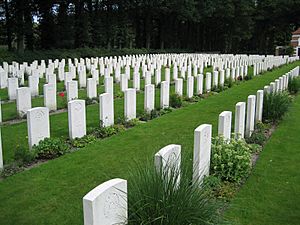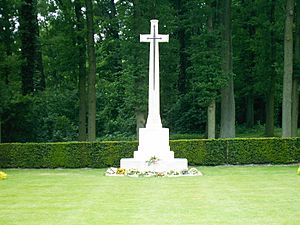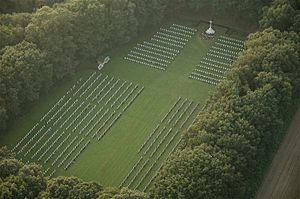Arnhem Oosterbeek War Cemetery facts for kids
Quick facts for kids Arnhem Oosterbeek War Cemetery |
|
|---|---|
| Commonwealth War Graves Commission | |

The Airborne Cemetery
|
|
| Used for those deceased 1944–1945 | |
| Established | 1945 |
| Location | 51°59′35″N 05°50′54″E / 51.99306°N 5.84833°E near Oosterbeek, Arnhem, Netherlands.
|
| Total burials | 1770 |
|
Unknowns
|
244 |
| Commemorated | 1691 |
| Burials by nation | |
|
United Kingdom: 1410
Poland: 73 Canada: 32 Netherlands: 6 Australia: 4 New Zealand: 4 |
|
| Burials by war | |
| Statistics source: Battlefields WWII Commonwealth War Graves Commission |
|
The Arnhem Oosterbeek War Cemetery, often called the Airborne Cemetery, is a special burial ground in Oosterbeek, near Arnhem, in the Netherlands. It was created in 1945 by the Commonwealth War Graves Commission. This cemetery is the final resting place for 1764 soldiers who died during World War II. Most of these brave soldiers were Allied servicemen. They were killed during the Battle of Arnhem in 1944 or when the city was freed in 1945. Even today, soldiers from these battles are still found. When they are, they are buried here, so the number of graves slowly grows.
Contents
The Battle of Arnhem: A Big Plan
In September 1944, the Allies launched a huge plan called Operation Market Garden. Their goal was to quickly end World War II. They wanted to get past Germany's defenses and reach its industrial heartland. To do this, they needed to capture several important bridges in the Netherlands. This would allow their ground forces to move quickly and cross the River Rhine.
The British 1st Airborne Division had the toughest job. They were sent to secure the bridges over the Lower Rhine at Arnhem. On September 17, they parachuted into the area. A small group managed to capture the Arnhem road bridge. However, German SS Panzer troops were unexpectedly in the area. This made it very hard for the Allies to fully control their targets. After nine days of fighting, without enough help from other Allied forces, the division had to pull back.
During these nine days, nearly 2000 Allied soldiers lost their lives. This included over 1174 British soldiers, 219 glider pilots, and 92 Polish soldiers. Many others from different units also died. The number of German soldiers killed is not fully known, but it was at least 1300. Sadly, 453 Dutch civilians also died during the battle.
The Airborne Cemetery: A Place of Rest
When the Allies had to leave Arnhem, most of their fallen soldiers were left behind. They were buried in simple graves or small mass graves dug by the Germans. After Arnhem was freed in April 1945, special British army units arrived. Their job was to find the Allied soldiers who had died.
A small field north of Oosterbeek was given to the Imperial War Graves Commission (now the Commonwealth War Graves Commission) in June 1945. This land was offered forever by the Netherlands government. The soldiers' bodies were then moved and reburied there. Many soldiers who died during Arnhem's liberation were also buried at this site. The cemetery was finished in February 1946. At first, the graves had metal crosses. These were replaced with proper headstones in 1952. Most German soldiers were later moved to the Ysselsteyn German war cemetery.
The Commonwealth War Graves Commission recorded 1759 graves in the cemetery by 2004. Of these, 1450 are Commonwealth soldiers from Britain, Canada, Australia, and New Zealand. The cemetery also holds the graves of 73 Polish soldiers and 8 Dutch civilians. About 244 of the graves are for soldiers who could not be identified.
Five soldiers received the Victoria Cross, Britain's highest award for bravery, after the battle. Four of them received it after they had died. Three of these heroes are buried in the cemetery:
- Lieutenant John Hollington Grayburn
- Flight Lieutenant David Samuel Anthony Lord
- Captain Lionel Ernest Queripel
Other Allied soldiers from the Battle of Arnhem are buried in different cemeteries. Some are in civilian cemeteries in the Netherlands, Belgium, the UK, and the USA. Sixty soldiers who died in prisoner of war camps are buried in Germany.
Airborne Commemoration Service
Every year, a special event is held at the Airborne Cemetery. It remembers the brave soldiers who fought in the Battle of Arnhem. In the summer of 1945, many soldiers who had fought in the battle came back to Arnhem. They helped film a war movie called Theirs Is the Glory. While there, they attended the very first memorial service at the cemetery.
This event has continued every year since. Veterans, local people, and over 1000 schoolchildren attend. The children lay flowers on the graves of the fallen soldiers. After the 25th anniversary in 1969, some thought about ending the ceremony. But the Dutch people strongly wanted it to continue. So, the ceremony is still held every year during the first weekend of September. It is a way to honor the soldiers and remember their sacrifice.
See also
- Airborne Museum The nearby museum about the battle.
- Airborne March The annual commemorative march around Arnhem.
- World War II memorials and cemeteries in the Netherlands
Nearby Commonwealth War Graves
- Groesbeek Canadian War Cemetery
- Mook War Cemetery
- Jonkerbos War Cemetery
- Rhenen Begraafplaats General Cemetery




